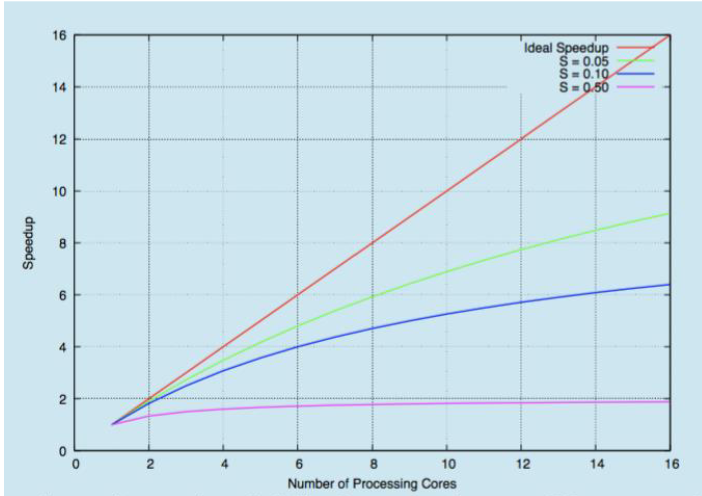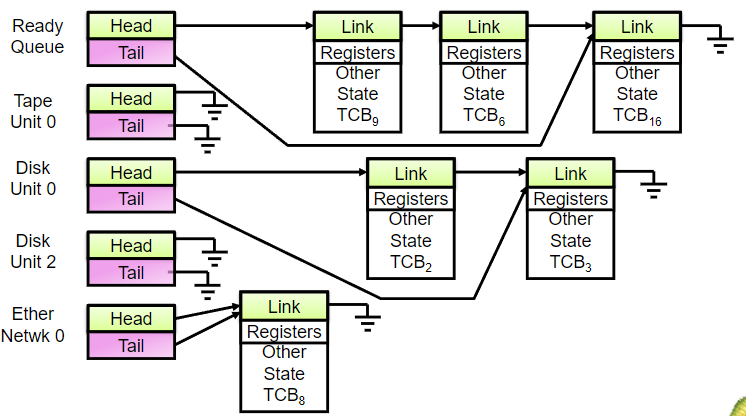COMP 3511: Lecture 9
Date: 2024-10-03 15:02:14
Reviewed:
Topic / Chapter:
summary
❓Questions
Notes
Multi-Threads Basics
-
Thread
- many app / programs: multithreads
- e.g. web browser: some displaying images, some retrieving data from internet
- or: each tabs in a browser
- to perform tasks efficiently
- e.g. web browser: some displaying images, some retrieving data from internet
- most OS kernels: multithreads
- e.g. multiple kernel threads created Linux system boot time
- motivation: can take advantage of processing capabilities on multicore systems
- i.e. parallel programming: often in data mining, graphics, AI
- process creation: time consuming and resource intensive
- thread creation: light-weight
- as thread shares code, data, and others within the process
- many app / programs: multithreads
-
Multithreaded program examples
- embedded systems
- elevators, planes, medical systems, etc.
- single program on concurrent operations
- most modern OS kernels
- internally concurrent: to deal w/ concurrent requests by multiple users
- no internal protection needed in kernel
- DB servers
- access to shared data of many current users
- background utility processing: must be done
- network servers
- concurrent requests from network
- file server / web server / airline reservation systems
- parallel programming
- split program & data into multiple threads for parallelism
- embedded systems
-
Single & multithreaded processes
- thread: basic unit of CPU utilization
- independently scheduled & run - instance of execution
- represented by
- thread ID
- program counter
- register set
- stack
- shares code, data, and OS resources: e.g. open files & signals
- efficiency: depends on no. of cores allocated to the process
- benefits
- responsiveness
- resource sharing
- threads: share process resource by default
- easier than inter-process shared memory / message passing
- as: threads run within the same address space
- economy
- thread creation: cheaper than process creation
- context switch: faster intra-process (thread) than inter-process
- scalability
- processes: can take advantage of multicore architecture
- thread: basic unit of CPU utilization
Multicore & Parallelism
-
Multicore design
- multithreaded programming: provides mechanism for more eff. use of multi-cores
- and improves concurrency in multicore systems
- ⭐👨🏫 L2 cache / memory are shared by cores

- multithreaded programming: provides mechanism for more eff. use of multi-cores
-
Multicore programming
- significant new challenges in multicore/multiprocess programming design
- dividing tasks: how to divide into separate / concurrent tasks
- balance: each task performing equal amount of work
- data splitting: data used by tasks: divided to run on separate cores
- 👨🎓 dividing seed among farmers to work concurrently
- data dependency: synchronization required if data dependency exist
- e.g. operation B: requiring completion of operation A
- testing and debuggingL different path of executions: makes debugging difficult
- parallelism != concurrency
- parallelism: system can perform more than one task simultaneously
- concurrency: supporting more than one task for making progress
- i.e. doing more than one job over a time
- when multiplexed over time: single process core, scheduler provides concurrency
- advent of multicore: requires new approach in software system design
- significant new challenges in multicore/multiprocess programming design
-
Concurrency vs. parallelism
- concurrent: single core multiplexing over time
- parallel: execution on a multi-core system
- 👨🏫 rigorously, parallelism only exists in multicore
- but many literatures don't differentiate them
- concurrent: single core multiplexing over time
-
Data & task parallelism
- data parallelism: distribute subset of data across multiple cores
- same operation on each core
- common: in distributed machine learning tasks

- task parallelism: distribute: threads across core
- each thread: performing unique operation

- data & task: not mutually exclusive: could be used at the same time!
- data parallelism: distribute subset of data across multiple cores
-
Amdahl's law
- designs performance gain from additional cores to an application
- w/ both serial and parallel components
- : serial portion
- : parallel portion
- : processing cores
- speedup
- as approaches infinity: speedup approaches
- serial portion of application: disproportionate effect
- on performance gained by adding additional cores
- e.g. if application if 75% parallel, 25% serial
- then moving from 1 to 2 cores: give speedup of
- 👨🏫 even if you have 5% of serial portion: speedup decreases significantly

- designs performance gain from additional cores to an application
Threads
-
Multithreaded processes
- multithreaded process: more than one instance of execution (i.e. threads)
- thread: similar to process, but shares the same address space
- state of each thread: similar to process
- with its of program counter and private set of register for execution
- two thread running on single process: switching from threads requires context switch, too
- register state of a thread: saved, and another thread's is loaded / restored
- address space: remains the same - much smaller context switch
- and thus much small overhead
- thus parallelism is supported
- enables overlap of IO with other each activities within a single program
- one thread: running on CPU; another thread doing IO
-
Thread
- thread: single unique execution context: lightweight process
- program counter, registers, execution flags, stack
- thread: executing on processor when it resides i registers
- PC register: holds address of currently executing instruction
- register: holds root state of the thread (other state in memory)
- each thread: w/ thread control block (TCB)
- execution state: CPU registers, program counter, pointer to stack
- scheduling info: state, priority CPU time
- accounting info
- various pointers: for implementing scheduling queues
- pointer to enclosing process: PCB of belonging process
- thread: single unique execution context: lightweight process
-
Thread state
- thread: encapsulates concurrency - active component of a process
- address space: encapsulates protection - passive part of process
- one program's address space: different from another's
- i.e. keeping buggy program from thrashing entire system
- state shared by all threads in a process / address space
- contents onf emory (global variables, heap)
- IO state (file descriptors, network connections, etc.)
- state not shared / private to each thread
- kept in TCB: thread control block
- CPU registers (including PC)
- execution stack: parameters, temporary variables, PC saved
-
Lifecycle of a thread

- change of state
new: thread being createdreadythread waiting to runrunning: instructions being executedwaiting: thread waiting for event to occurterminated: thread finished execution- or: killed by OS / user
- active threads: represented by TCBs
- TCBs: organized into queues based on states
-
Ready queue and IO device queues
- thread not running: TCB is in some queue
- queue for each device / signal / condition: w/ their own scheduling policy
- more accurate visualization of ready queue (instead of PCB, w/ TCB)

- thread not running: TCB is in some queue
-
User threads and kernel threads
- user threads: independently executable entity within a program
- created & managed by user-level threads library
- users: only visible to programmers
- kernel threads: can be scheduled & executed on a CPU
- supported & managed by OS
- users: only visible to OS
- example: virtually all-general purpose OS
- Windows, Linux, Max OS X iOS, Android

- user threads: independently executable entity within a program
-
Multithreading models
- as user threads: invisible to kernel
- => cannot be scheduled to run on a CPU
- OS: only manages & schedules kernel threads
- thread libraries: provide API for creating & managing user threads
- primary libraries
- POSIX Pthreads - POSIX API
- Windows threads - Win32 API
- Java threads - Java API
- primary libraries
- user-level thread: providing concurrent & modular entities
- in a program that OS can take advantage of
- 👨🎓 here! this can be done in parallel manner!
- if no user threads defined: kernel threads can't be scheduled either
- ❓ are kernel threads assigned on runtime?
- 👨🏫 yes; user threads are static though
- cycles of threads / control / etc.: applies to kernel threads
- in a program that OS can take advantage of
- example
pthread_t tid; /* creating thread */ pthread_create(&tid, 0, worker, NULL) - ultimately: mapping must exist for user-kernel threads
- common ways:
- many-to-one: many user-level thread to one kernel thread
- one-to-one: one user-level thread for a kernel thread
- most common in modern OS
- many-to-many: many user-level thread to many (usually smaller no. of) kernel thread
- as user threads: invisible to kernel

